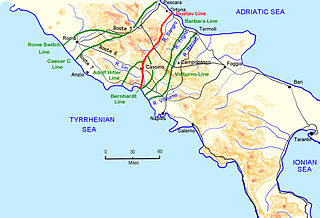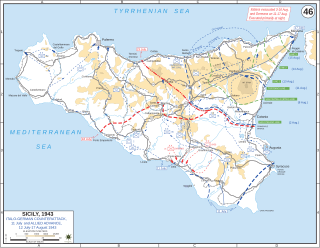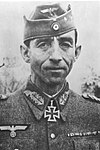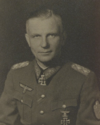
The Battle of Monte Cassino, also known as the Battle for Rome, was a series of four military assaults by the Allies against German forces in Italy during the Italian Campaign of World War II. The objective was to break through the Winter Line and facilitate an advance towards Rome.

The Battle of Anzio was a battle of the Italian Campaign of World War II that took place from January 22, 1944. The battle began with the Allied amphibious landing known as Operation Shingle, and ended on June 4, 1944 with the liberation of Rome. The operation was opposed by German and by Italian Repubblica Sociale Italiana (RSI) forces in the area of Anzio and Nettuno.

The Winter Line was a series of German and Italian military fortifications in Italy, constructed during World War II by Organisation Todt and commanded by Albert Kesselring. The series of three lines was designed to defend a western section of Italy, focused around the town of Monte Cassino, through which ran the important Highway 6 which led uninterrupted to Rome. The primary Gustav Line ran across Italy from just north of where the Garigliano River flows into the Tyrrhenian Sea in the west, through the Apennine Mountains to the mouth of the Sangro River on the Adriatic coast in the east. The two subsidiary lines, the Bernhardt Line and the Hitler Line, ran much shorter distances from the Tyrrehnian Sea to just northeast of Cassino where they would merge into the Gustav Line. Relative to the Gustav Line, the Hitler Line stood to the northwest and the Bernhardt Line to the southeast of the primary defenses.

Albert Kesselring was a German military officer and convicted war criminal who served in the Luftwaffe during World War II. In a career which spanned both world wars, Kesselring reached the rank of the Generalfeldmarschall and became one of Nazi Germany's most highly decorated commanders.

The military history of the United Kingdom in World War II covers the Second World War against the Axis powers, starting on 3 September 1939 with the declaration of war by the United Kingdom and France, followed by the UK's Dominions, Crown colonies and protectorates on Nazi Germany in response to the invasion of Poland by Germany. There was little, however, the Anglo-French alliance could do or did do to help Poland. The Phoney War culminated in April 1940 with the German invasion of Denmark and Norway. Winston Churchill became prime minister and head of a coalition government in May 1940. The defeat of other European countries followed – Belgium, the Netherlands, Luxembourg and France – alongside the British Expeditionary Force which led to the Dunkirk evacuation in June 1940.

The Allied invasion of Sicily, also known as the Battle of Sicily and Operation Husky, was a major campaign of World War II in which the Allied forces invaded the island of Sicily in July 1943 and took it from the Axis powers. It began with a large amphibious and airborne operation, followed by a six-week land campaign, and initiated the Italian campaign.

The 1st Airborne Division was an airborne infantry division of the British Army during the Second World War. The division was formed in late 1941 during the Second World War, after the British Prime Minister, Winston Churchill, demanded an airborne force, and was initially under command of Major-General Frederick A. M. "Boy" Browning. The division was one of two airborne divisions raised by the British Army during the war, with the other being the 6th Airborne Division, created in May 1943, using former units of the 1st Airborne Division.

The Volturno Line was a German defensive position in Italy during the Italian Campaign of World War II.

Operation Slapstick was the code name for a British landing from the sea at the Italian port of Taranto during the Second World War. The operation, one of three landings during the Allied invasion of Italy in September 1943, was undertaken by airborne troops of the British 1st Airborne Division, commanded by Major-General George Hopkinson.

The Italian campaign of World War II, also called the Liberation of Italy following the German occupation in September 1943, consisted of Allied and Axis operations in and around Italy, from 1943 to 1945. The joint Allied Forces Headquarters (AFHQ) was operationally responsible for all Allied land forces in the Mediterranean theatre and it planned and led the invasion of Sicily in July 1943, followed in September by the invasion of the Italian mainland and the campaign in Italy until the surrender of the Axis forces in Italy in May 1945.

The VI Corps was activated as VI Army Corps in August 1918 at Neufchâteau, France, serving in the Lorraine Campaign. Constituted in the Organized Reserves in 1921, it was allotted to the Regular Army in 1933 and activated on 1 August 1940 at Fort Sheridan, Illinois. VI Corps took part in some of the most high-profile operations in World War II.

The 90th Light Infantry Division was a light infantry division of the German Army during World War II that served in North Africa as well as Sardinia and Italy. The division played a major role in most of the actions against the British Eighth Army in the Western Desert Campaign and eventually surrendered to the Allies in the final stages of the Tunisia Campaign in May 1943. It was re-constituted later in 1943 and deployed to Sardinia and when the expected Allied invasion of Sardinia failed to materialise, the division was moved to Italy. It was engaged in actions against the Allies in Italy from 1943 to April 1945 when the division was listed as "destroyed" in the Po River valley.

The Mediterranean and Middle East Theatre was a major theatre of operations during the Second World War. The vast size of the Mediterranean and Middle East theatre saw interconnected naval, land, and air campaigns fought for control of the Mediterranean, North Africa, the Horn of Africa, the Middle East and Southern Europe. The fighting lasted from 10 June 1940, when Italy entered the war on the side of Germany, until 2 May 1945 when all Axis forces in Italy surrendered. However, fighting would continue in Greece – where British troops had been dispatched to aid the Greek government – during the early stages of the Greek Civil War.

The 78th Infantry Division, also known as the Battleaxe Division, was an infantry division of the British Army, raised during the Second World War that fought, with great distinction, in Tunisia, Sicily and Italy from late 1942–1945.

The spring 1945 offensive in Italy, codenamed Operation Grapeshot, was the final Allied attack during the Italian Campaign in the final stages of the Second World War. The attack in the Lombard Plain by the 15th Allied Army Group started on 6 April 1945 and ended on 2 May with the surrender of all Axis forces in Italy.

The United States Army North (ARNORTH) is a formation of the United States Army. An Army Service Component Command (ASCC) subordinate to United States Northern Command (NORTHCOM), ARNORTH is the joint force land component of NORTHCOM. ARNORTH is responsible for homeland defense and defense support of civil authorities. ARNORTH is headquartered at Fort Sam Houston, Texas. Redesignated ARNORTH in 2004, it was first activated in early January 1943 as the United States Fifth Army, under the command of Lieutenant General Mark W. Clark.

I Canadian Corps was one of the two corps fielded by the Canadian Army during the Second World War.

The Adriatic campaign of World War II was a minor naval campaign fought during World War II between the Greek, Yugoslavian and Italian navies, the Kriegsmarine, and the Mediterranean squadrons of the United Kingdom, France, and the Yugoslav Partisan naval forces. Considered a somewhat insignificant part of the naval warfare in World War II, it nonetheless saw interesting developments, given the specificity of the Dalmatian coastline.

The 65th Infantry Division was a German division in World War II. It was formed in July 1942.

The 231st Brigade was an infantry brigade of the British Army that saw active service in both the First and the Second World Wars. In each case it was formed by redesignation of existing formations. In the First World War, it fought in Palestine and on the Western Front, while during the Second World War it served in the Allied invasion of Sicily, Italy and the Normandy landings of 6 June 1944.



























